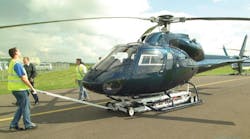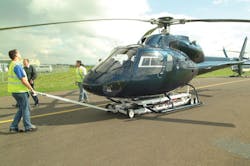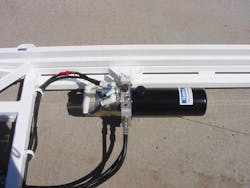Because helicopters rise straight up when they take off, they don’t need a long runway to become airborne. And because of this, the majority of helicopters (except for some larger models) are manufactured without wheels. Instead, they are fitted with landing skids.
All well and good — until you have to move a helicopter after it’s on the ground. Starting up and flying a copter from one part of an airport to another is expensive (requiring a pilot) and disruptive (with noise and windblown debris). It is common at many facilities for some form of ground handling arrangement to essentially jack up a helicopter, put wheels under it, and require a gang of people to manually reposition the combination — consuming a lot of time and occasionally injuring a finger or two.
Hydraulics goes to work
In the tradition of a better mousetrap, the Heliporter comes to the rescue. The Heliporter is a self-propelled platform that carries a vertical hydraulic lift. Its low-to-the-ground profile enables a single operator to maneuver the unit under a parked helicopter, easily avoiding contact with antennas, lights and other hanging accessories, then lift and transport the aircraft. The Heliporter can handle most light- and medium-duty helicopters. Its design is simple and easy for operators to learn and understand. A number of fail-safe features protect personnel and equipment, even when moving the typical heavy and awkward loads.
The platform’s hydraulic functions are supplied from a packaged power unit consisting of a 2500-psi gear pump, 12- or 24-Vdc electric motor, and reservoir. A pair of on-board 12-V batteries powers the motor, and integral battery chargers (standard on all units) keeps them energized when the system is not in use.
The operator starts the pump with a toggle switch at the control handle in front of the Heliporter. This switch is preloaded toward its off position so the pump automatically stops whenever the switch is released.
Propulsion and lift circuits
A simple twist grip, near the toggle switch at the same control handle, shifts the valves that operate the smooth, variable-speed hydrostatic drive that propels the Heliporter. A pair of low-speed/high-torque hydraulic wheel motors drives two sets of wheels each at the rear of the vehicle. The grip is spring-loaded toward its neutral center position which blocks flow to the motors and thus provides hydrostatic braking whenever the grip is released.
The operator selects forward or backward movement of the platform by the direction he or she rotates the twist-grip handle, as well as its speed, determined by the degree of rotation. A full rotation of the twist grip produces the Heliporter’s 21⁄2-mph maximum ground speed. Power steering, supplied with bypass oil flow, makes life much easier for the operator.
The operator can position the Heliporter under an aircraft by turning the grip into a detented mode that lets the wheel motors freewheel (with the pump running) during final manual adjustments. After the lifting platform is properly aligned under the aircraft, the twist grip is released to neutral to block flow in the wheel-motor circuit and effectively brake the Heliporter in place.
The operator now strokes the 21⁄2- by 10-in. lift cylinders (in a separate circuit) with a lever that shifts valves to select up or down movement. Once the helicopter’s skids have reached the desired height off the ground, the lever is allowed to return to its neutral position. The valves then block flow in the lift circuit, and the lift cylinders hold their positions until the operator moves the lever to lower the helicopter into a new parking position.
A bright future
Officials at Paravion are considering making the Heliporter even more maneuverable by incorporating an all-wheel steering option. Paravion Technology is in the process of evaluating what performance advantages all-wheel steering can offer.
With a consistently increasing use of light- to medium-size helicopters flying today, Paravion’s safe, simple, and reliable ground-transportation system has gained widespread use around the globe.
More than 1200 Heliporters are now in operation, with steady orders coming in from all over the world — from as far away as Russia. Customers include law enforcement and medical helicopter operations, as well as commercial services and private operators.
This information was provided by Scott Holst, marketing manager, and Lon Carlson, retired, Paravion Technology Inc., Fort Collins, Colo.
Click here to see a video of Paravion's Heliporter in use.



